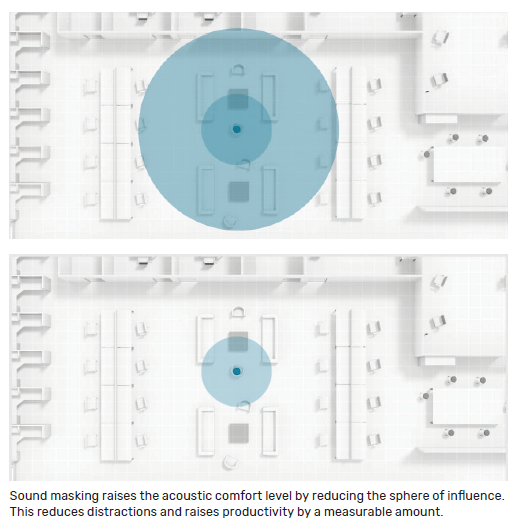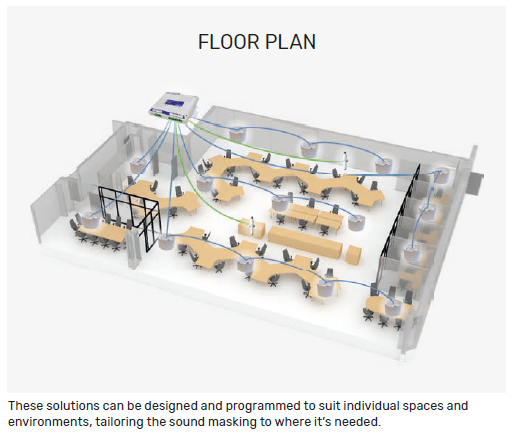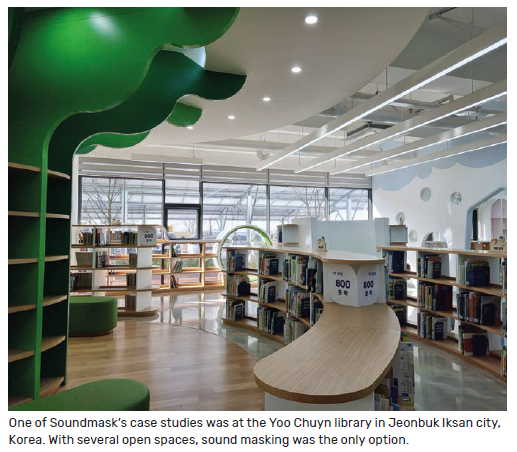Mask your office distractions
Sound masking technology is a simple solution to speech privacy problems, employee comfort and acoustic distractions. Sean Carroll finds out how it works and what integrators can offer clients.
Fighting fire with fire, sound masking technology is one method integrators can use to stop noise pollution in commercial and industrial settings, alongside a bevy of other benefits.
ADVERTISEMENT
Unlike the active noise-cancelling technology we see in headphones, cars and some residential environments, sound masking introduces more sounds to a space. By emitting a soft, inconspicuous background sound (a mixture of pink noise, white noise and others) with a loudspeaker, people aren’t able to hear any unwanted sounds in their environment.
This is perfect for office spaces where lots of background noise can distract workers. On top of that, it shortens the distance that sounds travel, keeping private conversations safe to have in the workplace.
Several companies work in this area, delivering quiet, efficient workplaces where they can. Soundmask has its own range of products, Jands distributes the Cambridge Sound solutions and MadisonAV distributes the Roadworx products.
“Our systems emit a sound similar to airflow which is produced by a randomised digital sound generator that can be shaped by an equaliser,” Soundmask managing director Megan Short says.
Soundmask is an Australian technology company that specialises in acoustic treatments and sound masking, creating comfortable acoustic environments in markets across the world.
“The noise that our products emit increases the background sound level so that when other sounds intrude, they’re not as noticeable. The correct sound will effectively mask speech and many other sounds as well.”
MadisonAV distributes the Roadworx sound masking solutions, a range of controllers, loudspeakers, software, sensors and accessories. MadisonAV product line manager Rob Mayer adds: “As crazy as it sounds, adding noise to a space actually makes it seem quieter. This added sound masks the intelligibility of human speech.
“The ambient sound level becomes more uniform, and otherwise noisy distractions are muffled. This helps keep your private meetings private, improves focus, decreases workplace distractions and increases productivity.”
The Soundmask solutions are controlled digitally, either on the unit itself, via a computer or through an app. Users can tap individual speakers for a more nuanced sound masking solution in different zones throughout a building.
The most recent solution from Soundmask is the GQ Series, a plug-and-play device that comes as a three, two or one-zone solution. It aims to miniaturise the sound masking system to the extent that one SM-GQ-8 product can control up to 800 speakers in one RU rack space, which is about 20,000m2, so a very powerful device.
AV distributor Jands also works in the sound masking space with its Cambridge Sound range of solutions. Cambridge Sound, Roadworx and Soundmask’s products can be installed anywhere, either hanging from the ceiling, mounted in-wall or even on the floor.
“Our sound masking controllers are discrete and cost-effective and are usually hiding in the IT rack or services room,” Jands business development manager Glenn Ryan says.
“They’re configured from a simple, secure browser interface. Using standard network cabling infrastructure, we can combine indirect emitters hidden away in the ceiling cavity and direct emitters that install directly into the ceiling tiles to best suit the specific environment.”
The Cambridge Sound solutions combine a mix of indirect and direct emitters and can be interfaced via analogue or networked audio (Dante or AVB). On top of sound masking, these products can be used for distributing background audio throughout the workplace or public address paging.
The most recent solution from Jands is the Cambridge Qt X, an all-in-one sound masking solution that’s capable of controlling either direct and/or indirect sound masking installations on a single system. It aims to give integrators the flexibility to design solutions that meet end-user architectural requirements without compromises.
With the Qt X, users can support up to 55 controllers and up to 110 independent paging zones from either analogue or networked paging stations. Additionally, the REST application programming interface enables third-party control compatibility for integrators.
“These features scale up as networked audio sources, as well as integration to existing EWIS/fire safety systems and can be used with multiple sound masking generators to provide complete building solutions,” Glenn outlines.
Megan says that nearly all Soundmask’s customers are in the commercial market, the only time they’ve worked in residential is when installing sound masking solutions for several apartments, as part of a commercial build.
“We see a lot of our products installed by law firms, accountants and financial advisors, spaces where it’s crucial to have private speech,” she says.
“We’re also seeing it installed in health settings by psychologists, allied health doctors and hospitals and other places like security, justice applications, parole officers/prisons, police stations and international summits like the G20.”
She says that Soundmask has had a lot of success with these private settings because they don’t have any microphones in their products: “That lack of microphones is for a reason. If we want to go into these industries, a lot of the time, they don’t want to have any third-party products recording their conversations.
“Also, some of the offices we’ve installed products in don’t have WiFi so that they can remain secure. Our products are designed with that level of security in mind.”
One case study where Soundmask excelled was in a Melbourne office that had been built within an old warehouse in Collingwood. With high ceilings, open plan design and hard surfaces in every direction, it was almost impossible to get work done in the studio.
Soundmask installed several speakers throughout the warehouse and achieved the client’s goal of masking the intelligibility of speech for boardroom meetings. The transducers and acoustics discs were made to seamlessly blend into the environment, maintaining an urban, industrial design.
“A lot of thought goes into the design of our products, making sure that the final product fits into its environment,” Megan explains.
“Our speakers are made of ABS plastic, so they can be painted if you want to blend into a particular colour scheme. The products can be hung from the roof, mounted on the wall or even placed on the floor, depending on where the end user wants them.”
Rob from MadisonAV says that sound masking solutions help enable modern workplaces. The adaptable Roadworx range can work within many diverse interior design trends and materials of the modern-day office such as exposed ceilings, movable glass walls, sliding doors, skylights and acoustic tiles.
Jands is also seeing success with these products in open-plan offices. While they can create appropriate working environments in these spaces, they’re also pushing back in the other direction and making office spaces even more productive.
And outside of new, trendy builds, sound masking can work as a retrofit solution. MadisonAV has found that by adding sound masking solutions to a call centre environment, productivity increased by 20% compared to before.
The International WELL Building Institute includes sound masking as an important aspect of comfortable and productive workplaces. WELL Building Standard v2 doesn’t just recommend the use of sound masking, it outright calls for it.
“WELL v2 devotes an entire optimisation feature to increasing acoustical privacy within and between occupied spaces by uniformly elevating their ambient background sound level using an adjustable array of loudspeakers,” MadisonAV’s Rob says.
“It is also explicit about how ambient background sound provided by HVAC systems alone can’t be relied upon for ensuring proper, consistent acoustical privacy.”
Jands business development manager (integrated systems) Christopher Ling says that the corporate world is starting to see the great benefits of elevating the employee experience: “This technology has a big impact on assisting people and culture teams across the globe and it provides a new level of confidence in the employee value proposition for returning to the office and re-engaging with office spaces.”
While all the solutions mentioned offer control of each individual speaker, it’s important to note that sound masking is essentially a set-and-forget technology, either with automatic noise detection or by selecting a consistent level for the lifetime of the product.
With Soundmask’s solutions, it’s not a case of turning up the noise to see greater benefits or a lower radius of disturbance.
“While you can change the sound levels or turn it off or on, the idea behind sound masking is to set the level and leave it on for the life of the system,” Megan says.
“It’s important to know that you’re creating an environment. Sound masking technology should exist just like creating an acoustic environment, like putting a panel in or something structural. You want to set the noise to a comfortable level and then never change it. People should walk into work and not notice anything different.”
Chris Ling says that the Cambridge Sound products work similarly, setting a target level and then leaving it alone: “This is to achieve the goal of being an unobtrusive and consistent experience.
“If the background noise in the space grows louder than the sound masking signal, then the sound masking will be almost unnecessary. Once the background noise drops again, the sound masking will seemingly take over again maintaining a consistent minimum noise floor.”
Roadworx operates differently. Rob says that its sound masking solutions can be adapted in real-time: “The system continuously adjusts the masking sound level based on ambient noise measurement. In a busy work area, the masking sound increases. It decreases when the work quietens down.
“Office spaces are dynamic environments where ambient noise and the number of distractions vary constantly throughout the day. To be truly effective, sound masking must seamlessly increase as the office gets busier and become more subtle as things go quieter.”
He adds that automatic volume control makes this possible, adjusting the level of noise as sound in the environment increases.
Moving forward, Jands is focusing on helping grow the technology. Glenn notes that sound masking is growing at an extraordinary rate and the technology itself has improved so much that it’s less invasive than air conditioning: “Because of its success, we’re seeing sound masking used in several new builds and refurbishments.”
Soundmask is spending a lot of time in R&D, ensuring that they stay ahead of the curve with this technology. Megan explains how her team is working on a traffic noise preset for larger residential builds in CBDs.
“We have a bit of a live case study at the moment because of the 24/7 building works as part of Melbourne’s Big Dig,” she says.
“It’s a great natural experiment because we can measure sleep disturbance between the houses that have sound masking installed and the ones that don’t. That’s one area that, at least me personally, I’m very interested in.”
This research is a great test case for why sound masking solutions are opting to create multiple different zones across an installation. Not every room has the same noise disturbance with some rooms closer to noise sources than others. With different zones, each room can have a noise level tailored to specific needs.
When integrators are working on fitting out the latest and greatest into a commercial build, it’s important to note that even if the collaboration technology and AV components are top-notch, they’re useless without a healthy working environment.
There is a range of sound masking solutions on the market to deliver a quiet, private working environment in a traditional or open plan setting. It might sound counterintuitive, but the best way to cut down on noise disturbances is to add more noise, it just has to be the right noise.
-
ADVERTISEMENT
-
ADVERTISEMENT
-
ADVERTISEMENT
-
ADVERTISEMENT




